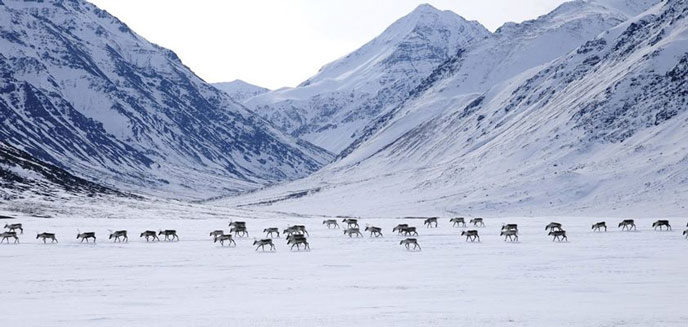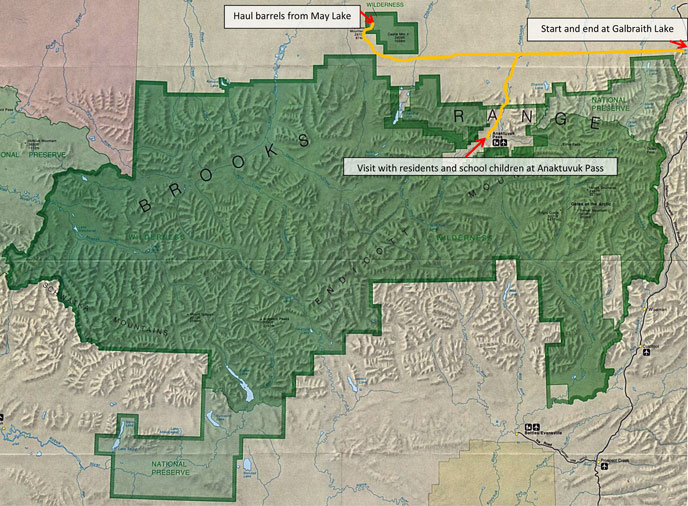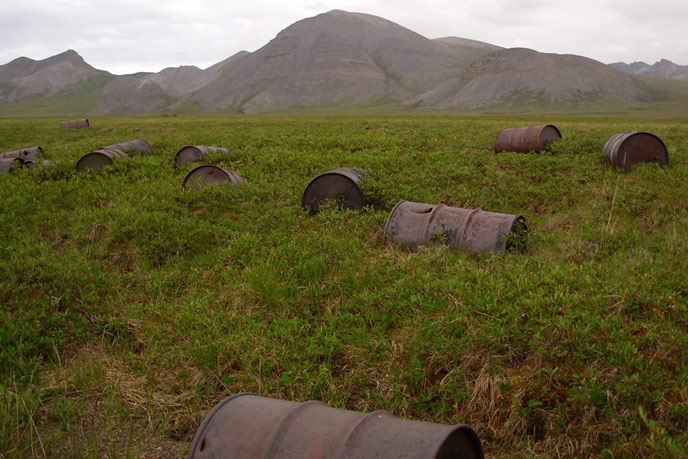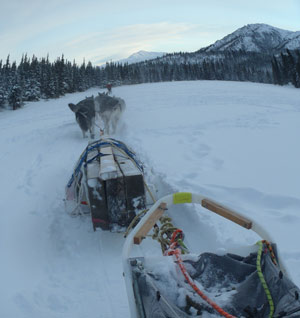
Caribou are one of the many species to thrive throughout Gates of the Arctic National Park. (NPS Photo)
Two Kennels Rangers and 20 of the Denali NPS sled dogs are leaving the park and heading north to assist Gates of the Arctic National Park and Preserve with several projects honoring the 50th Anniversary of the Wilderness Act.

Gates of the Arctic is the second largest national park as well as one of the most remote.
Denali is unique in that we have one ribbon of road that extends through the wilderness in summer and makes it easier for thousands of people to access the two million acres of designated wilderness. Gates of the Arctic National Park and Preserve protects over 8 million acres (four times the size of Yellowstone) and is managed primarily as wilderness. GAAR is special because it has no roads; access is accomplished by plane, on foot, by boat, dog team, skis, etc. allowing for “solitude or a primitive and unconfined type of recreation.” We are honored and excited to partner and travel with several of the GAAR staff on a multi day trip in primitive fashion decreed by the Wilderness Act.
You will be able to follow along on our journey with our mapping page.
To learn more about where we are going please visit Gates of the Arctic’s website at and watch a slideshow of a mushing trip in the area put together by Zak Richter.
According to their website, Gates of the Arctic National Park and Preserve lies entirely north of the Arctic Circle. Its austere beauty and grandeur defy description. It includes the scenic headland of the Brooks Range, the northernmost extension of the Rocky Mountains. This is the ultimate wilderness that captured the heart and imagination of Arctic explorer Robert Marshall in the 1930s. The 1980 legislation (Alaska National Interest Lands Conservation Act or ANILCA) that created the park and the preserve protected 8.4 million acres. It mandated that the area be managed to maintain its wild and undeveloped character, opportunities for solitude, and the environmental integrity of its natural features and to provide for wilderness recreation. Fish and wildlife, arctic habitats, cultural resources, and traditional subsistence uses also were protected. With the adjacent Noatak National Preserve and Kobuk Valley National Park, Gates of the Arctic comprises one of the world's largest parkland areas.
One of the projects we will be assisting with is the removal of old 55 gallon metal drums from May Lake which is within designated wilderness in the northwest corner of the park. We will use dog teams to enter this area and haul the drums out for disposal. This is part of a much larger, ongoing cleanup effort to remove these drums from various land areas of importance to the residents of Anaktuvuk Pass. To learn more read a Fairbanks Daily News Miner article about this wilderness cleanup project.

In the summer the oil barrels left by military personal in the 50s are apparent across the landscape. One of our challenges may be digging these out of snowdrifts to haul. (NPS Photo)
Why use dog teams to accomplish this? NPS Wilderness management policy states that (we will) “Perform any necessary wilderness management work, which should be undertaken only after determining the “minimum requirement,” with the “minimum tool.” The “minimum tool” has the least discernible impact on the land.” In this case, the minimum tool for the project is dog teams. You can read some of our previous blogs to learn more about the pros and cons of using dog teams versus snowmachines for travel and work in Alaska in winter. Remember, it says minimum tool with the least impact on the land, not fastest or easiest way to get the job done.

We plan to spend time in the schools talking with students about our NPS sled dogs and how we use them to achieve Wilderness preservation goals in Denali. We also hope to spend time with the elders listening and recording their stories of their own use of dog teams for travel and work in the past and present. One of the kennels goals is to document and share the evolving history of the use of sled dogs across Alaska.
We are excited to have the opportunity to travel and work with the Gates of the Arctic staff and hope to return with some inspiring stories for you. We also hope that a few of you will read this and decide to experience some of this vast and beautiful wilderness in Alaska for yourself, maybe on a summer backpack or float, maybe on a bus ride to Wonder Lake, perhaps on a winter visit to see the northern lights or, perhaps, to drive your own dog team into the winter white wilderness. Alaska contains over half of all the designated wilderness in the US so plan plenty of time to explore.
Everyone has their own personal reasons for traveling into wilderness landscapes. Each of us is affected in different ways by the experience of exploring in remote, wild places. The common ground is that every single one of us returns changed, affected in some way by the land, the forces of nature, the people we encounter on the journey.
On this journey we expect to be affected by all these forces, but are also hoping to give back. We venture into the GAAR wilderness to uphold the Wilderness Act's principals of leave no trace travel, to reaffirm that people can travel primitively across a vast landscape, and also work to improve these areas that provide us so much.
Please tell us below, how has Alaska’s Wilderness affected you?
